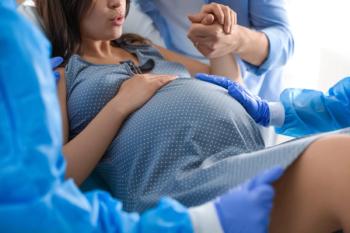
Placenta and Umbilical Cord
The foetal blood in the chorionic villi is separated from the maternal blood, in the intervillous spaces, by the Placental Barrier which is composed of :1. Endothelium of the foetal blood vessels, 2. The villous stroma, 3. The cytotrophoblast, and 4. The syncytiotrophoblast.
Origin:The placenta develops fromgthe chorion frondosum( foetal origin)and decidua basalis( maternal origin).
Anatomy At Term
Shape : discoid.
Diameter : 15-20 cm.
Weight : 500 gm.
Thickness: 2.5 cm at its center and gradually tapers towards the periphery.
Position : in the upper uterine segment (99.5%), either in the posterior surface (2/3) or the anterior surface (1/3).
Surfaces
• Foetal surface
• Maternal surface
a. Foetal surface
• Smooth, glistening and is coveredby the amnion which is reflectedon the cord.
• The umbilical cord is inserted nearor at the center of this surface andits radiating branches can be seenbeneath the amnion.
b. Maternal surface
• Dull greyish red in colour andis divided into 15-20cotyledons.
• Each cotyledon is formed ofthe branches of one mainvillus stem covered by deciduabasalis.
Functions Of The Placenta
(1) Respiratory function
(2) Nutritive function
(3) Excretory function
(4) Production of enzymes
(5) Production of pregnancy associated plasmaproteins (PAPP)
(6) Barrier function
(7) Endocrine function
(1) Respiratory function:
• O2 and CO2 pass across the placenta by simplediffusion.
• The foetal haemoglobin has more affinityand carrying capacity than adult haemoglobin.
• 2,3 diphosphoglycerate (2,3-DPG) whichcompetes for oxygen binding sites in thehaemoglobin molecule, is less bounded to thefoetal haemoglobin (HbF) and thereby allows agreater uptake of O2 ( O2 affinity).
(1) Respiratory function
The rate of diffusion depends upon:
1. Maternal/ foetal gases gradient.
2. Maternal and foetal placental bloodflow.
3. Placental permeability.
4. Placental surface area.
(2) Nutritive function
The transfer of nutrients from the mother tothe foetus is achieved by :
1. Simple diffusion : e.g. water andelectrolytes.
2. Facilitated diffusion: e.g. glucose.
3. Active diffusion: e.g. amino acids.
4. Pinocytosis: e.g. large protein moleculesand cells.
(3) Excretory function
Waste products of the foetusas urea are passed tomaternal blood bysimple diffusionthrough the placenta.
(4) Production of enzymes:
e.g.:
• Oxytocinase,
• Monoamino oxidase,
• Insulinase,
• Histaminase and
• Heat stable alkaline phosphatase.
(5) Production of pregnancy associated l i (PAPP) e g plasma proteins e.g.
• PAPP-A,
• PAPP-B,
• PAPP-C,
• PAPP-D and
• PP5.
The exact function of these proteins is not defined.
(6) Barrier function:
The foetal blood in the chorionic villi is separated from the maternal blood, in the intervillous spaces, by the Placental Barrier which is composed of :
1. Endothelium of the foetal blood vessels,
2. The villous stroma,
3. The cytotrophoblast, and
4. The syncytiotrophoblast.
(6) Barrier function:However, it is an incomplete barrier.
• It allows the passage of antibodies(IgG only), hormones, antibiotics,sedatives, some viruses as rubellaand smallpox and some organisms astreponema pallida.
• Substances of large molecular size asheparin and insulin cannot pass theplacental barrier.
(7) Endocrine function
(A) Protein hormones:
1- Human chorionic gonadotrophin (hCG)
2- Human placental lactogen (hPL)
3- Human chorionic thyrotrophin (hCT)
4- Hypothalamic and pituitary like hormones
5- Others as inhibin, relaxin and beta endorphins.
(B) Steroid Hormones:
1- Oestrogens
2- Progesterone
(A) Protein hormones:
1- Human chorionic gonadotrophin (hCG)
- It is a glycoprotein produced by the syncytiotrophoblast.
- It supports the corpus luteum in the first 10 weeks of pregnancy to produce oestrogen and progesterone until the syncytiotrophoblast can produce progesterone.
1- Human chorionic gonadotrophin (hCG) HCG molecule is composed of 2 subunits
a. Alpha subunit: which is similar to that of FSH, LH and TSH.
b. Beta subunit: which is specific to hCG.
1- Human chorionic gonadotrophin (hCG)
• HCG rises sharply after implantation, reaches a peak of 100.000 mIU/ml about the 60 th day of pregnancy
• then falls sharply by the day 100 to 30.000 mIU/ml and is maintained at this level until term.
1- Human chorionic gonadotrophin (hCG)
• Estimation of beta-hCG is used for:
a) Diagnosis of early pregnancy.
b) Diagnosis of ectopic pregnancy.
c) Diagnosis and follow-up of trophoblastic disease.
2- Human placental lactogen (hPL)
- It is a polypeptide hormone produced by the syncytiotrophoblast.
- The supposed actions of hPL include:
a. Lipolysis:
increasing free fatty acids which provide a source of energy for mother and foetal nutrition.
b. Inhibition of gluconeogenesis:
thus spare both glucose and protein explaining the anti-insulin effect of hPL.
c. Somatotrophic
: i.e. growth promotion of the foetus due to increased supply of fatty acids, glucose and amino acids.
d. Mammotropic and lactogenic effect.
- HPL can be detected by the 5-6th week of pregnancy, rises steadily until the 36th week to be 6 mg/ml.
- Its level is proportional to the placental mass.
3- Human chorionic thyrotrophin (hCT)
No significant role has been established but it is probably responsible for:
1. Increased maternal thyroid activity and
2. Promotion of foetal thyroid development.
4- Hypothalamic and pituitary like hormones
e.g.:
1. Gonadotropin releasing hormone (GnRH)
2. Corticotropin releasing factor (CRF),ACTH
3. Melanocyte stimulating hormone, (MSH).
5- Other hormones as :
1. Inhibin,
2. Relaxin and
3. Beta endorphins.
(B) Steroid Hormones
1- Oestrogens
2- Progesterone
1- Oestrogens:
- They are synthesized by syncytiotrophoblast from their precursors:
1. dehydroepiandrosterone sulphate (DHES) or its
2. 16 ? -hydroxy (16 ? - OH- DHES).
1- Oestrogens:
Near term 50% of DHES is1 - term, derived from the fetal adrenalgland and 50% from maternaladrenal.-
It is transformed in the placentainto oestradiol- 17b (E2).
1- Oestrogens:
• On the other hand , 90% of16 OH DHES i d i dg? - - is derivedfrom foetal origin afterhydroxylation of DHES in thefoetal liver,
• While only 10% is derivedfrom the mother by the sameway.
1- Oestrogens:
• Oestrogens are inexcreted the maternal urine asoestriol (E3), oestradiol (E2)and oestrone (E1).
• Oestriol (E3) is the largestportion of them.
1- Oestrogens:Maternal urinary and serum oestriol isgyan important index for foetal wellbeingas: its synthesisdepends mainly on the integrity of thefoetal adrenal and liver as well as theplacenta (foeto- placentalunit).
1- Oestrogens:
- Urinary oestriol increases as g pregnancy advances to reach 35- 40 mg per 24 hours at full term.
- Progressive fall in urinary oestriol indicates that the foetus is jeopardous.
Oestrogens are responsiblewith progesteronefor the most of the maternalchanges due to pregnancyespecially that in genitaltract and breasts
2- Progesterone:
• It is synthesized ogeste o ebysyncytiotrophoblast fromthe maternal cholesterol.
• Excreted in maternalurine as pregnandiol.
Abnormalities Of The Placenta
(A) Abnormal Shape
(B) Abnormal Diameter
(C) Abnormal Weight
(D) Abnormal Position
(E) Abnormal Adhesion
(A) Abnormal Shape:
1. Placenta Bilobata
2. Placenta Bipartite
3. Placenta Succenturiata
4. Placenta Circumvallata
5. Placenta Fenestrata
1. The placentaBilobata:consists of twoequal lobesconnected byplacentaltissue
2. Placenta Bipartite:
• The placenta consists of two equal parts connected by membranes.
• The umbilical cord is inserted in one lobe and branches from its vessels cross the membranes to the other lobe.
• Rarely, the umbilical cord divides into two branches, each supplies a lobe.
3. Placenta Succenturiata:
• The placenta consists of a large lobe and a smaller one connecting together by membranes.
• The umbilical cord is inserted into the large lobe and branches of its vessels cross the membranes to the small succenturiate (accessory) lobe.
3. Placenta Succenturiata:
• The accessory lobe may be retained in the uterus after delivery leading to postpartum haemorrhage.
• This is suspected if a circular gap is detected in the membranes from which blood vessels pass towards the edge of the main placenta.
• A whitish ring composed of decidua, is seen around the placenta from its foetal surface.
• This may result when the chorion frondosum is two small for the nutrition of the foetus, so the peripheral villi grow in such a way splitting the decidua basalis into a superficial layer ( the whitish ring) and a deep layer.
4. Placenta Circumvallata:
It can be a cause of :
1. Abortion,
2. Ante partum haemorrhage,
3. Preterm labour and
4. Intrauterine foetal death.
5. Placenta Fenestrata:
A gap is seen in the placenta covered by membranes giving the appearance of a window.
(B) Abnormal Diameter:
Placenta membranacea:
• A great part of the chorion develops into placental tissue.
• The placenta is large, thin and may measure 30-40 cm in diameter.
• It may encroach on the lower uterine segment i.e. placenta praevia.
(C) Abnormal Weight:
The placenta increases in size and weight as in :
1.Congenital syphilis,
2.Hydrops foetalis and
3.Diabetes mellitus.
(D) Abnormal Position:
Placenta Praevia:
The placenta is partly or completely attached to the lower uterine segment
In this gravid uterus, the placenta implanted over the os.This is called placenta previa.Implantation in this low lying position can lead toextensive hemorrhage as the dilation of the cervixdisrupts the placenta.
(E) Abnormal Adhesion:
Placenta Accreta:
• The chorionic villi penetrate deeply into the uterine wall to reach the myometrium,due to deficient decidua basalis.
• When the villi penetrate deeply into the myometrium, it is called "placenta increta" and
• When they reach the peritoneal coat it is called "placenta percreta".
(F) Placental Lesions
1- Placental Infarcts:
Seen in placenta at term, mainly in hypertensive states with pregnancy.
a. White infracts: due to excessive fibrin deposition. (Normal placenta may contain white infracts in which calcium deposition may occur).
b. Red infarcts : due to haemorrhage from the maternal vessels of the decidua.
(Old red infarcts finally become white due to fibrin deposition).
2- Placental Tumour:
Chorioangioma :
is a rare benign tumour of the placental blood vessels which may be associated with hydramnios.
The Umbilical Cord
Anatomy
• Origin : It develops from the connecting stalk.
• Length: At term, it measures about 50 cm.
• Diameter: 2 cm.
The Umbilical Cord
Structure: It consists of mesodermal connective tissue called Wharton's jelly, covered by amnion.
It contains:
1. One umbilical vein carries oxygenated blood from the placenta to the foetus
2. Two umbilical arteries carry deoxygenated blood from the foetus to the placenta,
3. Remnants of the yolk sac and allantois.
Here is a normal three vessel umbilical cord.Note that there are two arteries toward the right and asingle vein at the left.Most of the cord consists of a loose mesenchyme withintercellular ground substance (Wharton's jelly).
The Umbilical
• The cord is inserted in the foetal surface of the placenta near the center "eccentric insertion" (70%)
• Or at the center "central insertion" (30%).
AbnormalitiesOf TheUmbilical Cord
(A) Abnormal cord insertion:
1. Marginal insertion : in the placenta ( battledore insertion).
2. Velamentous insertion: in the membranes and vessels connect the cord to the edge of the placenta.
• If these vessels pass at the region of the internal os , the condition is called " Vasa praevia".
Vasa praevia
Vasa praevia can occur also when the vessels connecting a succenturiate lobe with the main placenta pass at the region of the internal os
Velamentous insertion
( B) Abnormal cord length:
1. Short cord which may lead to : ) g i-Intrapartum haemorrhage due to premature separation of the placenta,
ii-Delayed descent of the foetus druing labour,
iii-Inversion of the uterus.
Newsletter
Get the latest clinical updates, case studies, and expert commentary in obstetric and gynecologic care. Sign up now to stay informed.
















